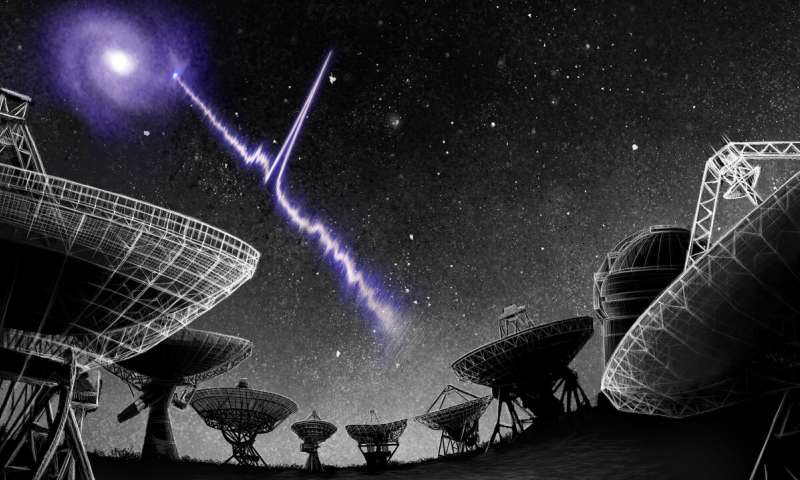On Jan. 6, McGill astronomers tracked down one of the brightest known repeating signals in the universe to a specific part of a galaxy just seven light years wide. The signal, called a Fast Radio Burst (FRB), was first detected in part by the Canadian Hydrogen Intensity Mapping Experiment (CHIME) telescope, a research collaboration between several McGill researchers and astrophysicists around the country.
FRBs interest astronomers because their origins and properties are not well understood. In astrophysical terms, brightness describes the apparent electromagnetic energy emission of some cosmic object when viewed from Earth. Essentially, this means that very bright signals correspond to high-energy events like stars going supernova. The event must be particularly high energy if it is coming from very far away. However, it is still unknown what event or events FRBs correspond to.
FRBs have an incredible amount of light energy packed into regions spanning only a few light years across. These bursts, which last less than five milliseconds, have surprised several astronomers. In fact, when the first one was discovered in 2007, there were doubts that it was even real.
Shriharsh Tendulkar, former postdoctoral fellow in the Department of Physics at McGill and a co-author of the FRB article published in the journal Nature, discussed the possible sources of FRBs and the many questions that these strange interstellar phenomena pose to researchers.
Tendulkar first explained that FRBs are similar to pulsars, magnetized rotating neutron stars that similarly emit immense amounts of light radiation.
“FRBs are a trillion times more powerful [than pulsars],” Tendulkar wrote in an email to The McGill Tribune. “We have no idea how to physically make bursts that are this bright and this frequent.”
By improving their understanding of FRBs, researchers seek to better postulate what kinds of cosmological objects emit them. So far, astronomers have categorized different types of FRBs into those that repeat and those that do not so that they can compare them and learn from their differences.
The next step after discovering an FRB is to localize it within a galaxy. Localization places the signal within an environment where only certain stars, gases, and other cosmological objects exist. The process allows astronomers to reason about what created the signal. Researchers have already localized a repeating FRB and several non-repeating FRBs to very different host environments. A few non-repeating FRBs have been discovered in large elliptical galaxies where few young stars are being formed. In contrast, the first localized repeating FRB was found in a dwarf galaxy with an abundance of young stars.
The FRB that CHIME discovered, however, was emanating from a completely new environment, different from those where previous FRB signals have been found.
“We discovered [the FRB] to be in a large spiral galaxy, where there are young stars but the gas is not as pure as in a dwarf galaxy,” Tendulkar said. “This means that whatever is forming these FRBs should be able to form in a lot of different environments.”
According to Tendulkar, the ability of FRBs to originate from diverse environments is just the beginning of what this newly documented radio burst can teach scientists about where electromagnetic energy comes from in space. The recently discovered FRB is the closest such signal to Earth and provides the opportunity for new avenues of research. Specifically, researchers can look more closely at the amount of energy released in the burst and electron and magnetic field distribution around the source. They could possibly even study corresponding bursts that travel at other frequencies, such as infrared radiation or X-rays.
Tendulakr noted that the following months will be a crucial period in understanding FRBs.
“We will be able to study [the FBR] in far greater detail than previously known,” Tendulkar said. “We are now in the process of submitting many proposals to different telescopes to meticulously study this FRB and its environment.”









Fascinating article! Great to learn of all the reserach being done at McGill